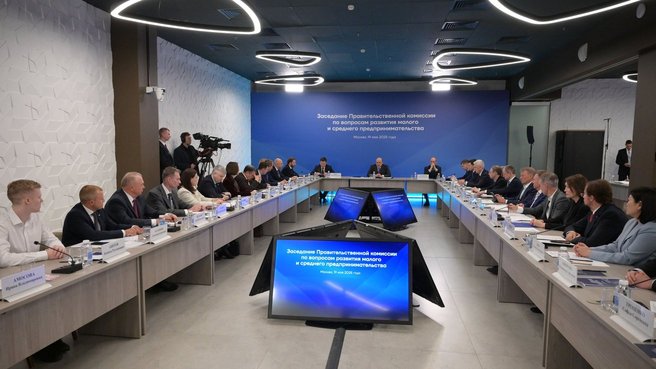Mikhail Mishustin: “Last year, we finished implementing a specialised national project that made it possible to formulate an integrated system of support – from start-ups to entering export markets. We overfulfilled the objective, set by the President, while increasing the workforce of small and medium-sized businesses. By the end of 2024, their number exceeded 29.3 million people.”
Mikhail Mishustin’s opening
remarks
Alexander Novak’s report on the status of small and medium-sized businesses and their role in achieving
national goals, including under a new federal project

Meeting of the Government Commission on the Development of Small and Medium Businesses

Meeting of the Government Commission on the Development of Small and Medium Businesses

Meeting of the Government Commission on the Development of Small and Medium Businesses

Meeting of the Government Commission on the Development of Small and Medium Businesses

Alexander Novak’s report at a meeting of the Government Commission on the Development of Small and Medium Businesses
Meeting of the Government Commission on the Development of Small and Medium Businesses
Excerpts from the transcript:
Mikhail Mishustin: Good afternoon, colleagues.
I am delighted to greet all of you.
We have just inspected the Lomonosov cluster. This is a very good example how
one centre can combine various measures for supporting small and medium-sized
businesses, providing them with opportunities for growth and development and accomplishing several high-priority state objectives.
Today, at a meeting of the Government Commission on the Development of Small and Medium Businesses, we
will discuss key challenges now facing this sector. And, of course, we will
discuss the main priorities for the next few years.
The President devotes
considerable attention to this sphere that has become an inalienable part of our economy and one of its main driving forces. It helps forge a competitive
environment, provides employment and makes our regions stronger. What is no
less important is that it often gives rise to daring and innovative ideas promoting
our technological development, helping create new sectors and even entire
markets.
The Government actively assists
these businesses. Last year, we finished implementing a specialised national
project that made it possible to formulate an integrated system of support –
from start-ups to entering export markets. We will continue to strengthen this
sector, and I will certainly discuss this issue once again today.
We overfulfilled the objective,
set by the President, while increasing the workforce of small and medium-sized
businesses. By the end of 2024, their number exceeded 29.3 million people.
Of course, an increase in the number of entrepreneurs is the result of a set of measures, implemented in the past few years.
First of all, some of them were
enacted during the pandemic and when our country faced greater foreign
pressure. In this context, the Government’s quick response, in coordination
with the Bank of Russia, business associations, academic and expert communities
and regions, enabled many companies to retain their production facilities and jobs. High-priority sectors now employ many more people compared to 2019. This includes the tourism industry, the IT sector and processing industries.
The total amount
of state financial support is estimated at approximately 8.5 trillion roubles.
It was received by about half a million entrepreneurs. A programme of preferential lending, umbrella guarantees, leasing, guarantees of regional
guarantee organisations, and microloans were available.
We also actively
assisted in creating industrial and technology parks, where the main residents
are small and medium-sized businesses. We financed more than 50 such centres,
which accommodated 900 companies employing about 15,000 specialists.
We have also
launched the МСП.РФ digital platform. As I said, it differs a great deal
from the first version, and it is of a very high quality. By May 5, 2025, the number of services offered there exceeded 35. Entrepreneurs get help in a one-stop-shop mode: quickly, in a targeted manner and using convenient
services. It has become technologically advanced, accessible and covers practically
all stages and elements of business development.
We can see that
the impetus that was given to the sector is still effective today. The number
of small and medium-sized enterprises continues to grow. As of April 10, it had
already exceeded 6.71 million. Together, they already make up a fifth of our
economy.
Based on the analysis of the work of industrial clusters and their specialised
organisations, they adjusted the relevant regulatory framework. The concept of “intermediate
products” was introduced. We have defined the parameters of internal
development programmes and scientific infrastructure, which will make it
possible to involve those organisations, which are engaged in R&D and samples testing.
Plans are
underway to build 100 more industrial parks over the next five years. The call
for project bids for 2026 has already begun.
This groundwork
enables us to consider the SME sector as a tool for achieving several national
development goals until 2030, set by the President in his May Executive Order.
Specifically, it
can become a locomotive in such areas as the growth of export of non-resource
and non-energy goods, help ensure the country’s technological sovereignty,
increase the share of the tourism sector and promote the development of creative industries.
Over the next five years, key objectives will continue
to be carried out under the national project Efficient and Competitive Economy.
Several related measures are also outlined in other strategic documents, for instance, in the federal project focused on expanding domestic machine tool
production. This initiative includes targeted support for small enterprises
engaged in manufacturing high-demand products.
Existing support measures have also been extended. In April, the investment lending programme for priority sectors was relaunched,
with approximately 100 billion roubles allocated. These funds are intended to support the launch of new production lines, the purchase of equipment, and the expansion of output.
In the first quarter of this year, regional guarantee
organisations issued around 2,500 guarantees, enabling entrepreneurs to secure
nearly 110 billion roubles in credit. Additionally, more than 5,000 microloans
were issued, totalling approximately 12 billion roubles.
We will continue to strengthen the infrastructure for supporting small and medium-sized businesses across Russia’s regions. In particular, 1.5 billion roubles
will be allocated to further encourage SMEs to enter international markets.
Today, we will also address additional support
measures for participants of the special military operation. This includes
defining the role of My Business centres in assisting those who, following
demobilisation, choose to pursue entrepreneurial activities.
It is essential to continue efforts aimed at minimising
risks and eliminating barriers to ensure the sustainable growth of the sector,
while enhancing its contribution to the economy and addressing social
challenges.
One key objective is to create employment
opportunities for both young and older citizens. Young people, in particular,
are a vital source of fresh ideas and innovation, with a high degree of mobility. Since 2019, the number of young entrepreneurs has increased by 75
percent, now surpassing 270,000 individuals.
At the same time, individuals aged 60 and over are
also actively contributing to small enterprises. They play a key role as mentors,
sharing practical experience, leadership skills, and – crucially – a deep
understanding of their professions. Notably, this dynamics has also shown strong
growth, with a 70 percent increase since 2019.
Our current focus is on enhancing the resilience of small and medium-sized businesses through digitalisation, scaling operations,
and, importantly, fostering collaboration and expanding into new markets for their products and services.
The key objective through 2030 is to establish an environment where entrepreneurs feel confident, supported, and empowered to grow. Achieving this requires open, ongoing dialogue between businesses, the federal Government, regional authorities, and development institutions.
Our commission meetings serve as a vital platform for exchanging ideas and formulating additional measures to support the growth of small and medium-sized enterprises.
Colleagues,
I look forward to hearing compelling ideas and proposals today. Rest assured, the most constructive suggestions will be considered
and incorporated into efforts to enhance the regulatory framework, strengthen
production support mechanisms, and improve the service sector.
I would also like to highlight that today’s meeting is
being held on the eve of your professional holiday – Russian Entrepreneurship
Day, celebrated on 26 May. I take this opportunity to express my sincere
gratitude to all business leaders and entrepreneurs for their valuable
contribution to the positive transformations taking place across our country.
Congratulations to all on this occasion.
Let us begin our work.
Mr Novak, the floor is yours for the first report.

Alexander Novak’s report at a meeting of the Government Commission on the Development of Small and Medium Businesses
Alexander
Novak: Thank you. Mr Mishustin, colleagues.
Mr Mishustin has summarised the results of the national project. As the President instructed, we have achieved the key targets
in SME growth. An effective ecosystem has been built to support small
businesses. The new stage will focus on accelerating the qualitative
transformation of the sector.
The President has set a rather ambitious goal: by 2030, the actual income per employee of an SME must grow 20 percent faster than
the GDP. This will be done by strengthening the role of small businesses in the structural transformation of the economy, by advancing the technological
agenda, and the supply-side economy. Of course, we will also rely on smart
concentration of support measures under a new federal project, from competent
government agencies and development institutions.
The Government will thus tackle the following tasks
during the new national goal cycle.
First, increasing the contribution of small businesses
to the supply-side economy. In the past three years, the number of legal
entities and private entrepreneurs in small and medium-sized businesses has
grown across the catering industry, tourism, the IT sector and research.
Increasingly more companies are entering the production and processing sectors.
Businesses see development opportunities in the priority industries, and are set to develop them. The Government will support
this ambition.
The second task is to expand the involvement of SMEs
in cutting-edge technologies. There are over 4,500 small tech companies in Russia today, 90 percent being SMEs. They are mainly concentrated in Moscow, St
Petersburg, Tatarstan, and the Moscow and Sverdlovsk regions.
These companies are growing faster than expected:
their revenues and salaries are three to four times higher than across the SME
sector in general. We expect more companies like these to emerge and actively
integrate with the cooperation chains of the major corporations and the national projects focused on technological leadership.
The third task is to boost the competitive ability of SMEs when it comes to attracting qualified workforce. It is difficult for small
and medium-sized businesses to compete with large companies these days. The only way to go is boosting productivity. Their productivity is significantly
lower than that of large businesses.
This is why a new federal project has been developed
to ensure that all accents in support priorities and in the tools themselves be
made on increasing effectiveness and productivity.
A federal project structure has been built to solve
these tasks. The business associations actively involved include Opora Russia,
Delovaya Rossiya, the Chamber of Commerce and Industry, the Russian Union of Industrialists and Entrepreneurs, the relevant committee of the State Duma, and the competent commission of the State Council.
As a result, the federal project counts on the tools
that are most popular among businesses and produce the maximum effect.
First of all, it is the concessional lending programme
that has already been launched. We will fulfill the obligations we took up
earlier, which are to subsidise a portfolio built under this programme, or almost 700 billion roubles from over 60,000 entrepreneurs. We will grant new
concessional loans along with the Bank of Russia while prioritising investment
goals. We have shortlisted 17 partner banks. The lending process is on.
We have made the programme better targeted. We will
direct our support where it is truly needed for the development of the supply-side economy, supporting technological changes, and forming new markets
and industries.
Businesses will be
able to attract at least 1.2 trillion roubles of additional loans until 2030 thanks
to umbrella guarantees from the SME Corporation.
Programmes for preferential microloans and guarantees from regional funds have been extended,
which will allow businesses to jointly attract up to 1.6 trillion roubles in borrowed funds. State microfinance organisations will continue to provide loans
at preferential rates in the amount of up to five million roubles for up to three years.
Regional
guarantee organisations will provide up to 70 percent of the loan if the entrepreneur does not have collateral.
In order to create favourable conditions to attract investment, we will build 100 new
business parks, technoparks and industrial parks by 2030.
The sum of 30 billion
roubles has been allocated for this. Business funds
will also be attracted. At least 2,000 residents will be located in these
parks. The volume of extra-budgetary investments will amount to over 22 billion
roubles.
It is noteworthy
that all the regions will be able to join the programme, unlike the previous
period.
Taking this into
account, we have organised assessment and contest of projects for implementation starting in 2026, with 39 regions already submitting 89
projects. We are waiting for other regions to step in.
We will also
continue to ensure that
small and medium-sized
businesses have guaranteed sales of products.
The tool for the development of SMEs in the field of procurement introduced in 2022 under Federal Law No 223 (the growing programme)
and offset contracts help create a stable demand for SME technological products
for major customers. These include, for example, transponders for Rosavtodor,
drill pipes for Rosgeo, fire-resistant turbine oil for InterRAO among others.
As Mr Mishustin
pointed out, the МСП.РФ digital platform and My Business centres will also
continue operating.
We aim to shift
as much business interaction as possible into the digital space, which we see
as a priority. Over the past three years, small and medium-sized entrepreneurs
have accessed more than 300,000 regional support measures through the platform,
which now has over 1 million registered users.
It is also
important to continue developing physical
infrastructure supporting SMEs, above all My Business centres. These centres
serve to collect feedback from entrepreneurs, develop new programmes,
fine-tuning and integrating them with other support mechanisms.
Since 2019, My Business centres have expanded significantly and today include nearly 400 centres
across 88 regions of the Russian Federation. According to regional governors,
this is one of the most effective tools available: to date, 2.9 million
entrepreneurs have received assistance through these centres. In addition, My Business
centres are the first to address new tasks, such as supporting creative
industries and those participants of the special military operation and members
of their families who are interested in starting a business. These centres also work actively with youth and women on maternity leave.
Overall, 15,000
women have taken part in the programme, with 70 percent successfully launching
and growing their businesses across various sectors.
We also expect
that SMEs will play a large role in the creative economy. The President has set
the task of increasing the contribution of creative industries to the national
economy, which is in fact a new area for us.
We are working
closely with regional authorities to establish foundational institutions for creative sector growth at the local level. Given the strong multiplier effect
these industries provide, they represent a powerful lever for achieving our
broader national objectives in the SME sector. These topics will be explored in depth, Mr Mishustin, during the upcoming strategic session on the development
of creative industries.
In conclusion, I would like to note that SMEs have already become an essential part of the economy. Their numbers are steadily growing, and the Government has put in place all necessary tools to achieve the goals of qualitative change in the sector. Key programmes are now functioning at both federal and regional levels.
We will continue this work together with agencies, the State Duma, regions, and entrepreneurial organisations.
More to be posted soon…












